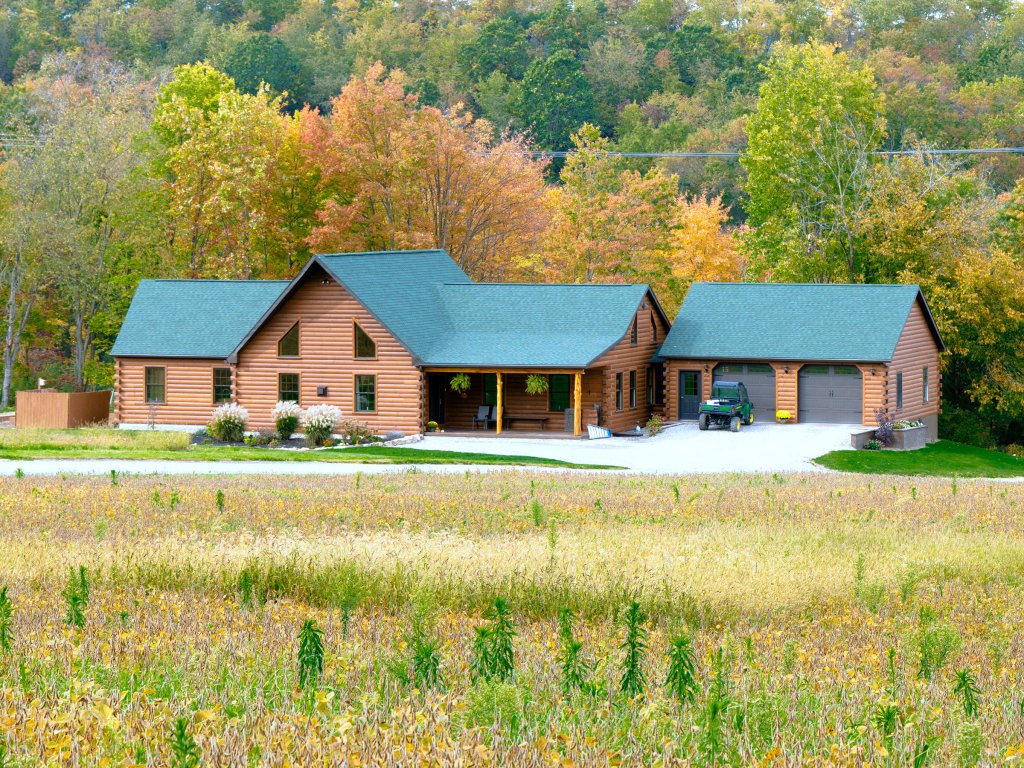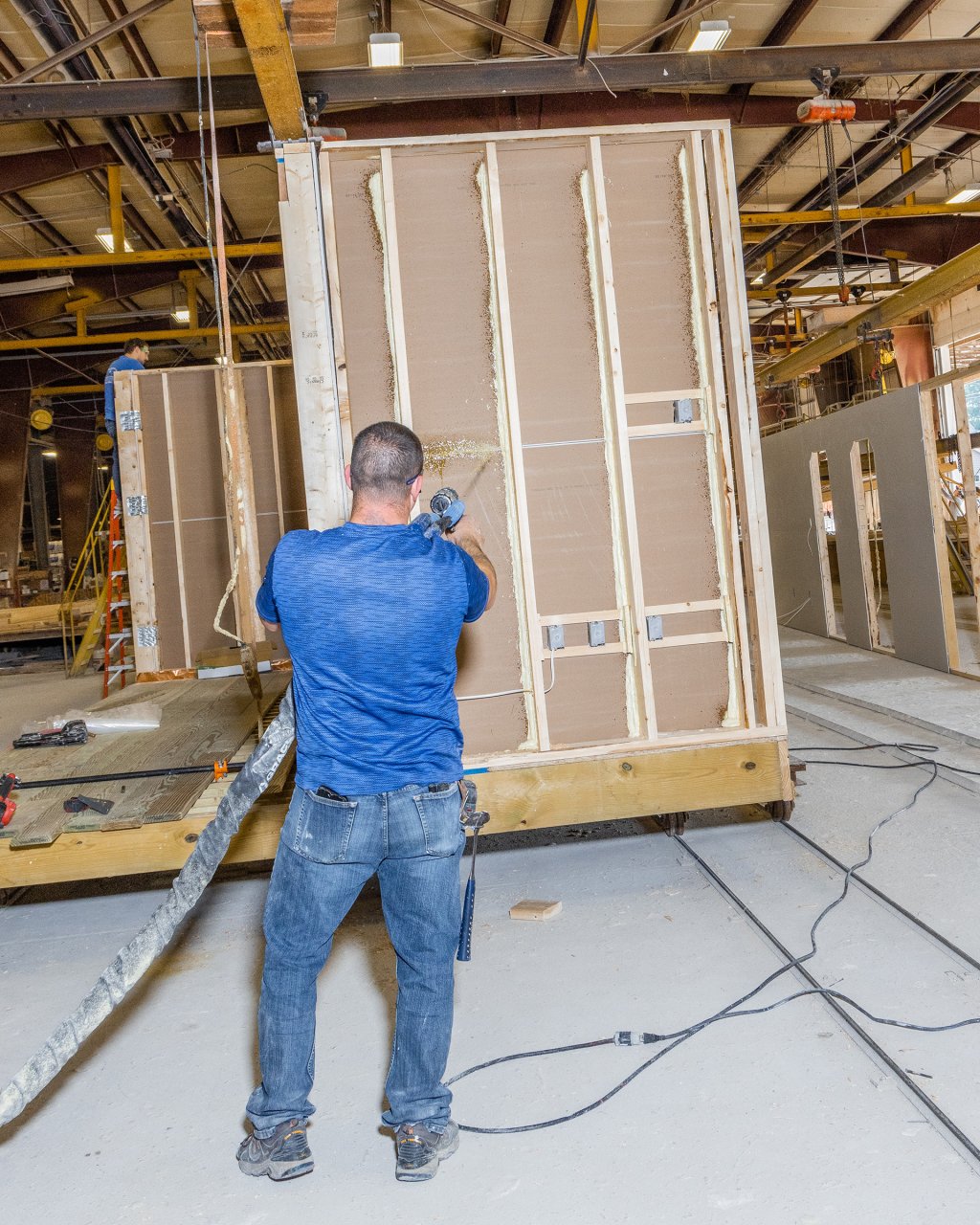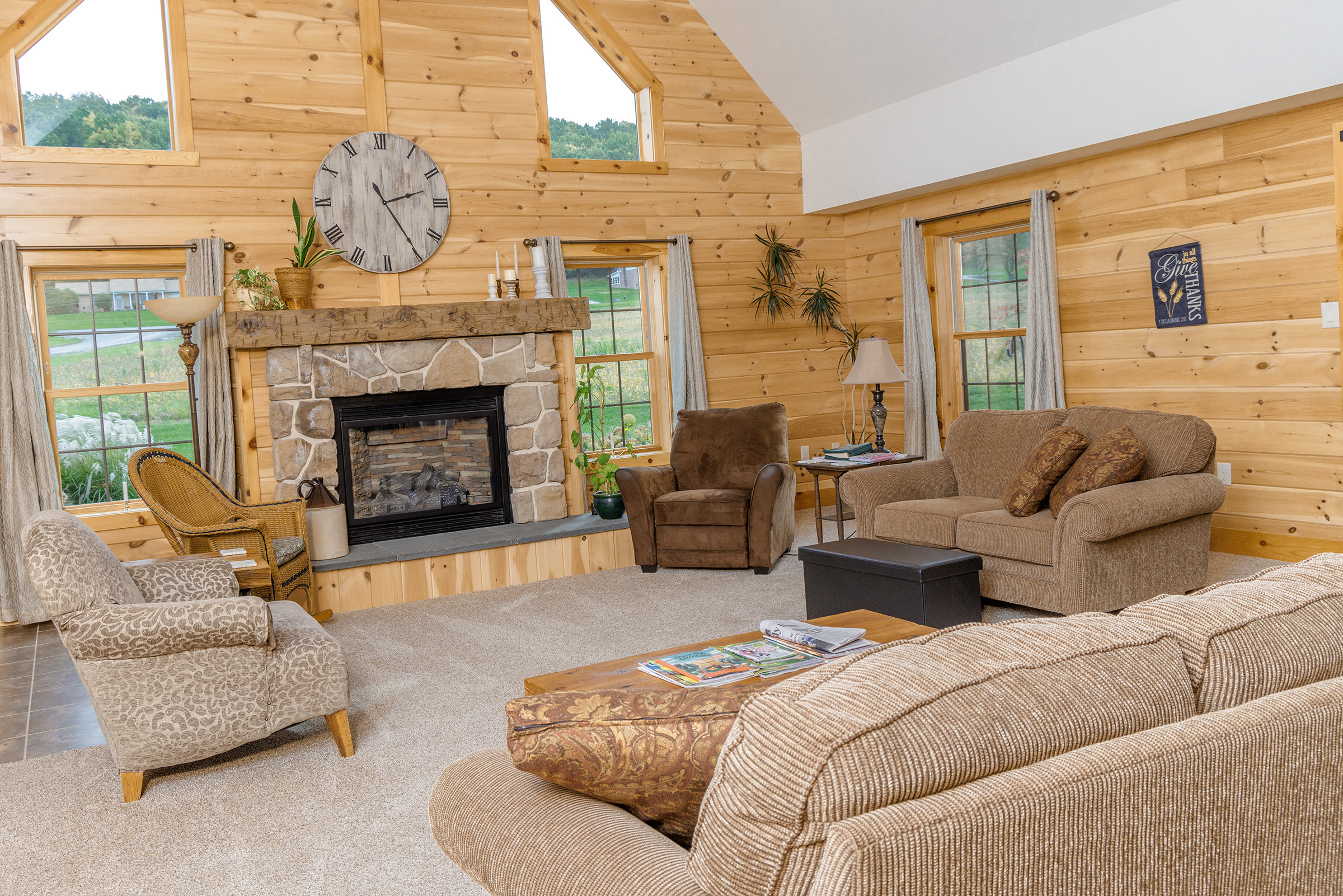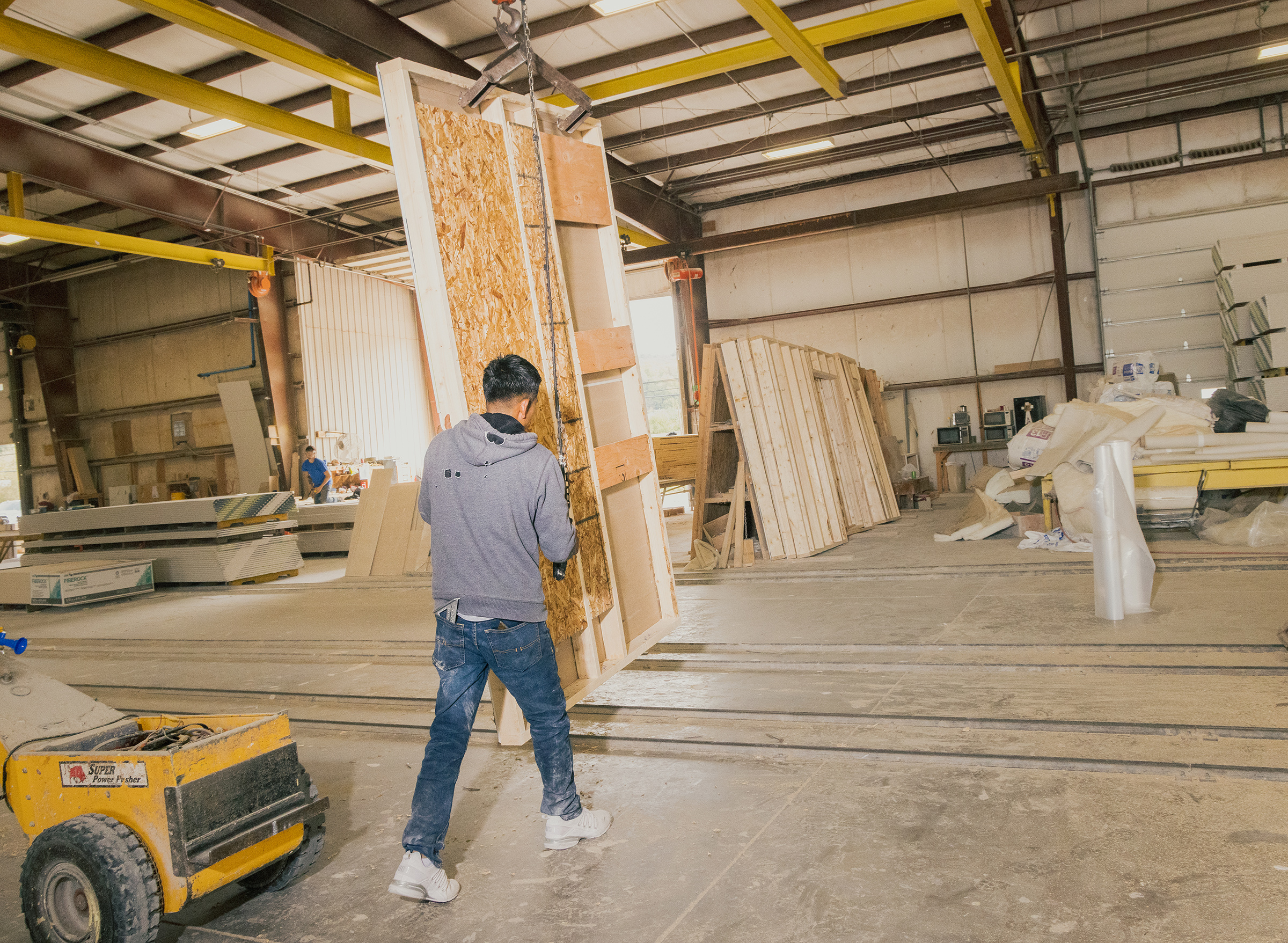Walking down the assembly line as the bell dings, marking a lunch break, Ken Semler points to a man carefully sealing the frame of a house with foam as evidence that this factory can build houses faster, cheaper, and better than traditional homebuilders.
“There’s no way you can do quality work in the field to the level you can in the factory,” says Semler, a tall, chatty man with a bristly mustache who is the president-elect of the Modular Home Builders Association. Factories like this one, run by a company called Apex Homes, may also be the key to solving America’s affordable housing crisis.
Sitting on the assembly line are so-called modules—pieces of a house—that will be wrapped in insulation and trucked to their final destination, which in this case is a ranch in Wyoming. There, a crane will put them together like a 3D puzzle. The whole process can be completed in a fraction of the time and at a lower cost than it would take to build a home on site.
“People are looking for an alternative way to build,” Semler says. “The old way is just getting too hard.”


The term “factory-built housing” might conjure the image of the small, boxy trailer-like home that sprung up to help address the housing crisis after World War II. But the modular homes manufactured here and in other factories are indistinguishable from the site-built homes in the neighborhoods they end up in. Unlike manufactured housing, which is wholly assembled in a factory and conforms only to a federal standard, modular housing is assembled on site and is required to follow specific state and local building codes. Companies build modular in styles like ranch, colonial, and chalet—Semler is building himself a 4,500 square foot modular home in Virginia in what he calls “Southern Living” style architecture.
Semler, who is also the CEO of a modular building company called Impresa Modular, has tried for years to convert the construction industry to off-site building (an industry term for modular.) A climate-controlled factory is a much easier place to build, he and other modular advocates argue, than a plot of land that is often remote, and that comes with unpredictable weather conditions. But in 2021, just 24,000 homes were built off-site, accounting for about 2% of all homes completed that year.
Still, the conditions may be right for modular single-family housing construction to finally take off, driven by a worsening shortage of construction workers and a growing housing affordability crisis. Home prices in September were 32% higher than they were in the same month in 2020, according to the S&P CoreLogic Case-Shiller National Home Price Index, and though higher interest rates may drive prices down, there is still a gaping shortage of housing in the United States. The country needs about 3.8 million more homes to keep up with population growth and make housing more affordable in its most high-opportunity areas.

“In the United States, we’re under-supplied and housing needs to be more affordable. I think this is definitely part of the solution,” says Ryan Marshall, the CEO of PulteGroup, America’s third-largest home construction company, about offsite manufacturing. In January 2020, PulteGroup acquired Innovation Construction Group, a Florida-based company that builds house wall panels, roof trusses, and floor systems in a factory. In mid-November of this year, PulteGroup announced that it was opening a second factory, in South Carolina. Marshall says he hopes to open eight factories across the country in the next decade, which will supply parts for 70% of the homes the company builds annually.
Off-site manufacturing can reduce the amount of time it takes to frame a home by 75%, he says, and the factory’s use of robotic saws and nailers helps build homes more precisely. Modular also helps the company do more with fewer workers. “Our fundamental belief is that the available labor that exists in our country to build homes is retiring quickly,” he says.
More from TIME
A broken construction industry
Marshall is correct that there is a growing labor shortage in the construction industry. The National Association of Homebuilders (NAHB) says that there were a record 449,000 unfilled job openings in the construction industry in April. That and pandemic-related supply shortages have lengthened the amount of time it takes to build a house, to eight months or longer, according to the NAHB. Modular homes, on the other hand, take about half as long to build—up from 5-6 weeks before the pandemic—and can cut costs by 20%, according to a 2019 McKinsey report.
Many housing analysts argue that the traditional construction industry has a productivity problem. Even before the pandemic, it took, on average, 7 months from start to completion on a house, according to Census data. In 1971, by contrast, the same process took just 4.8 months.

“It’s the only industry with negative traction,” says Margaret Whelan, who runs Whelan Advisory, an investment bank that works with construction companies trying to innovate. She calls the traditional construction industry and its big building companies “pale, male, and stale,” and suggests that is why they haven’t changed very much in decades.
The slow speed of housing construction has a very real impact on the average American, whether or not they are homeowners. If construction lags population growth, there is more demand for housing than there is supply, driving up costs.
Read More: Steamboat Springs’ Challenging Effort to House Everyone


Modular can speed up the construction process, advocates say. Modular home factories like Apex’s in Middleburg, Pa. can finish a home in a few weeks. Once the modules are shipped from the factory, the house can be assembled on site in a matter of days, or sometimes hours.
“If [modular construction] takes hold, it could give the industry a huge productivity boost, help solve housing crisis in many markets, and significantly reshape the way we build today,” a group of McKinsey partners wrote in the 2019 report, which also estimated that switching to modular could slash the time it takes to complete construction projects by 20% to 50%.
Building affordable housing faster
The bustling Middleburg factory shows just how efficient construction can be. Walk from one end of the cavernous factory to the other and you’ll see how a 64-foot by 13-foot floor—roughly the size of an oversized truck load—becomes a piece of a house, as workers add walls, windows, electrical wires, insulation, and siding as the module moves from one station to another on a rail track. At peak times, this happens quickly—Apex can move the modules down the assembly line as frequently as three times a day, meaning the floorboards of a house can move to the next station, where they get walls, insulation, and electrical wires. The company makes 175 to 200 homes a year, according to CEO Lynn Kuhns.
Some of the tasks that workers do on the assembly line might look familiar to anyone who has been on a construction site—at one station, a worker is hammering nails into the floorboards, while at another further down the assembly line, a worker pushes insulation into the walls. But certain technologies are unique to the modular sector, Semler says, like spray foam insulation, which helps create a thermal envelope that leaks less heat in the winter and cold air in the summer.
Because the work on the assembly line is repetitive, modular companies can bring in new workers who don’t have a lot of construction experience and train them to do one task, Semler says, which could help address the labor shortage in the construction industry.
Read More: The Cure for Inflation Means More Pain for Renters
The faster speed of the off-site construction industry appeals to people who don’t want to wait for years for a new home. Lori Griffin Schubert decided to buy a modular home after traditional builders told her that it would be at least a year and a half before they could start building her a home on a plot of land she and her husband had bought to retire on in western North Carolina. Schubert and her husband ended up paying $165 a square foot for their modular home, compared to the $400 per square foot they were getting quoted from on-site builders. It’s customized with a wood-burning fireplace, floor-to-ceiling windows, and 36-inch door, in case they need wheelchair access in the future, she says. The whole building process was completed in a few months, she says.

“The more people we talked to, the more we heard that the [traditional] builders are getting inferior labor and inferior supplies, but the modulars have to go through inspections in every single step and the quality is so high,” she says.
Habitat for Humanity of Dutchess County recently finished two modular homes—one with two bedrooms, one with three—for low-income families in Wappingers Falls, about 75 miles north of New York City. The nonprofit’s CEO, Maureen Lashlee, says that during the pandemic, her organization had a hard time finding volunteers, even though the region has a huge need for affordable housing, with 6,000 families who are priced out of the market and who would need to rely on Habitat if they want to own a home. “We have to find a way to step up our game and I honestly believe that modular is the way to do that,” Lashlee says.
In an effort to boost capacity, the Habitat for Humanity in Buffalo, N.Y. is leasing a warehouse space to test building its own modular houses, creating an assembly line where volunteers can come and learn the basics of building. It allows the nonprofit to buy materials in bulk and have more control over variables like weather and pace. “We anticipate it will be a cost-saver,” says Stephanie Lawson, director of development and communications at the nonprofit in Buffalo.
A sometimes risky bet
For the modular sector to really take off, people like Semler need to convince more big homebuilders like D.R. Horton and Lennar, America’s two largest, to build homes, or at least pieces of them, off-site in a factory. But the cost of failures is high in the construction industry. There have already been some high-profile modular companies that went bust. Katerra, a modular builder that received $500 million in funding from SoftBank, filed for bankruptcy in June 2021 because of pandemic-related financial challenges. Blu Homes, a much-heralded modular company founded in 2007, was sold to another company in 2020 with some observers speculating its homes were too niche. And in the U.K. this summer, a joint venture between Japanese modular giant Sekisui House and British developer Urban Splash, backed by Britain’s housing and regeneration agency Homes England, also collapsed.
Because offsite construction still isn’t very common, modular builders also run into regulatory hurdles that may prevent the industry from growing, says John Burns, the founder of John Burns Real Estate Consulting. Every city and town has its own zoning laws and few have the resources to explore and understand new types of construction. “The biggest issue they have with single-family homes is that local cities don’t want to see it” because it complicates the jobs of housing inspectors and officials, Burns says.


In most places, states delegate third-party inspection companies to work with modular builders, Semler says. The third-party company reviews and approves the building plan, which allows the customer to get a building permit, and then the third-party company performs an inspection at the factory while the modules are being built. Local building inspectors are supposed to accept factory inspections, but, Semler says, many are still learning how the process works. “If you’re the first modular into that county,” he says, “You got a lot of explaining to do.”
Some of modular construction’s cost savings come from the labor differential between how much workers are paid in the modular factories and how much they would be paid on site, which has made construction labor unions skeptical of the industry. As modular construction spreads, some labor groups are trying to make sure their jobs don’t get outsourced to rural factories. In the spring of 2022, New York State Senator Member Jessica Ramos, the chair of the Committee on Labor, introduced a bill that would require electrical and plumbing work for New York City modular construction to be supervised by a New York City-licensed worker—even if that work is usually done in a factory hundreds of miles away. The bill was passed by both the state Assembly and state Senate, and is awaiting Gov. Kathy Hochul’s signature, even though affordable housing advocates say it would be a blow to their efforts to reduce the cost of construction in New York City.
“We believe a bill like this will tack on additional costs even as the cost of construction goes up year after year,” says Katrell Lewis, VP, Government and Community Partnerships at Habitat for Humanity of New York City and Westchester County, which is building a few modular homes in Queens and has plans to use more modular units in its construction to reduce costs.

Opposition like New York’s may hurt factories like the one in Pennsylvania, that build whole modules in a factory and that usually work on custom projects. This suggests that companies like the one acquired by PulteGroup, which builds parts in a factory, rather than whole homes, may have an easier time growing. Marshall, of PulteGroup, says that he chose this method because it still requires local plumbers and electricians and complies with local building codes. It also allowed PulteGroup to continue building the floor plans that it has used for years, he says, which consumers know and love.
There are other forces that might drive more modular construction. In May, President Joe Biden announced a plan to increase housing supply over five years that included promoting modular housing. And in Europe, homebuilders trying to reduce emissions and meet ESG goals have turned to modular construction because it generates 37% less carbon dioxide and half the construction waste of site-built homes.
Construction industry data suggests that homebuilders are starting to think a little more about modular. About one-quarter of builders surveyed in September 2020 said they planned to use a type of modular roofing going forward, compared to just 15% who said that before the pandemic, according to Home Innovation Research Labs, a subsidiary of the NAHB. About 16% planned to use factory-built open wall panels, compared to 9% who said that before the pandemic, setting the stage for the acquisition of modular companies, as PulteGroup did.
Read More: 3-D Printed Homes Could Help Solve the Housing Crisis
Even if the housing market starts to falter, Semler is confident that modular will still do well. Because the process is so fast, he argues, modular construction will appeal to investors who are building homes to turn into rentals—they’ll be able to start collecting rent more quickly if they build with modular, he says.
If nothing else, he’s determined to build a community of modular homes to show that it can work. Semler’s company, Impresa Modular, has its own factory in South Carolina, and it inked a deal last year with developer SLV Windfall Group, to build hundreds of homes for Savannah Lakes Village, a private lakefront community. The modular homes are traditional-looking 3,500 square foot houses with finished basements and porches.
Impresa has agreed to build more than 100 homes a year for the foreseeable future there to help meet current demand. “I think the perfect storm of rising material costs and shortage of labor means that modular’s moment is here,” Semler says.
More Must-Reads from TIME
- Why Biden Dropped Out
- Ukraine’s Plan to Survive Trump
- The Rise of a New Kind of Parenting Guru
- The Chaos and Commotion of the RNC in Photos
- Why We All Have a Stake in Twisters’ Success
- 8 Eating Habits That Actually Improve Your Sleep
- Welcome to the Noah Lyles Olympics
- Get Our Paris Olympics Newsletter in Your Inbox
Contact us at letters@time.com
